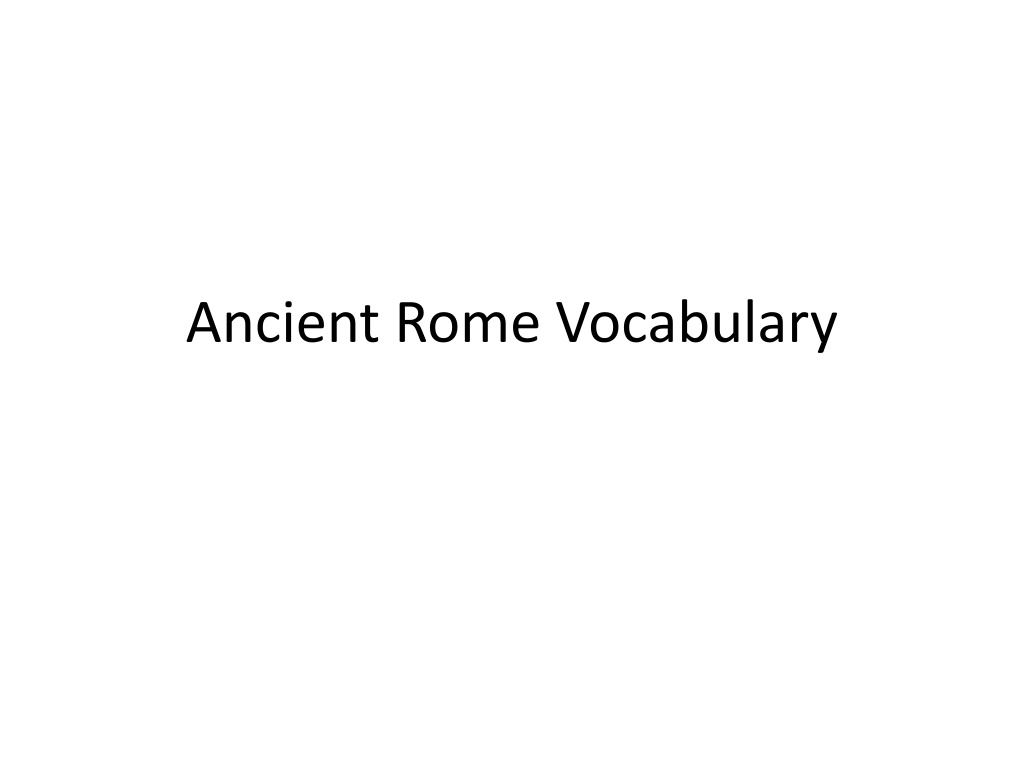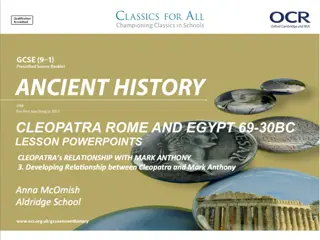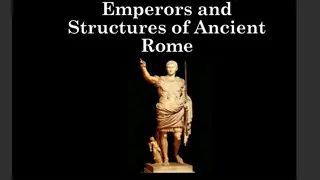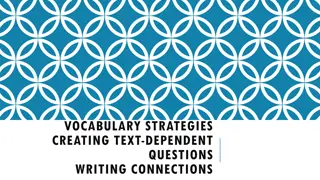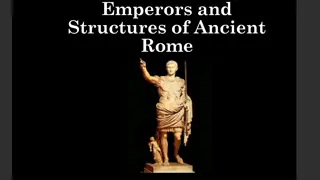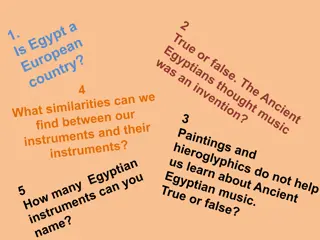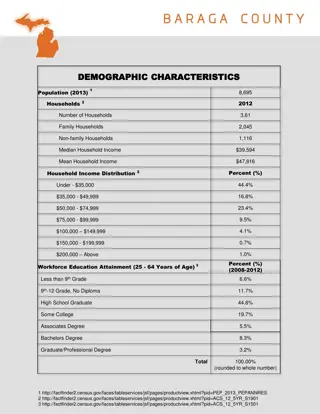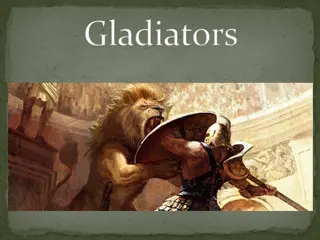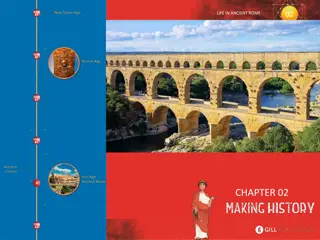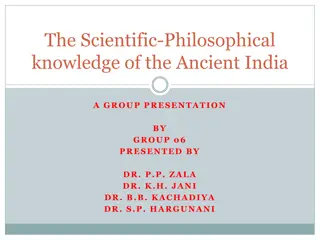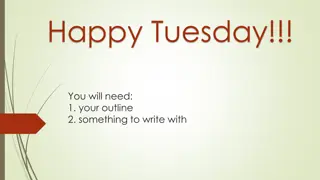Ancient Rome Vocabulary and Government Structure
Explore the key terms and concepts related to Ancient Rome, including the Roman Republic, Patricians, Plebeians, Twelve Tables, Senate, Consuls, Punic Wars, Pax Romana, and more. Learn about the structure of the Roman government, the social classes, significant historical events like the Punic Wars, and daily life in Ancient Rome.
Download Presentation

Please find below an Image/Link to download the presentation.
The content on the website is provided AS IS for your information and personal use only. It may not be sold, licensed, or shared on other websites without obtaining consent from the author.If you encounter any issues during the download, it is possible that the publisher has removed the file from their server.
You are allowed to download the files provided on this website for personal or commercial use, subject to the condition that they are used lawfully. All files are the property of their respective owners.
The content on the website is provided AS IS for your information and personal use only. It may not be sold, licensed, or shared on other websites without obtaining consent from the author.
E N D
Presentation Transcript
1) Republic- A form of Government with elected leaders. 2) Patricians- A wealthy landowner who held all the government positions at the beginning of the Roman Republic. 3) Plebeian- Peasants, Merchants and craftsmen who made up the lower class and 95% of the population (at first couldn t participate in the government. 4) Conflict of Orders - in 494 B.C.E., the plebeian class protested the Roman Republic and the plebeians rule by -leaving Rome in protest -they stopped working on the farms -refused to fight in the Roman Army. 5) Twelve Tables- First laws put in writing during the Roman Republic that explained what people could and couldn t do. 6) Constitution- Set of basic laws about a government 7) Tribune- An official of the Roman Republic elected by Plebeians to protect their rights. At first, they created laws just for Plebeians.
8) Senate- 300 men who governed Rome and were extremely powerful. They were elected for life and helped give advice to the two Consuls. Helped Control the state budget and could issue laws. 9) Consul- 2 Roman citizens elected by the assembly to serve a one year term to lead Rome. Head of the Army, Acted as Chief Priest, and Could direct the Government. 10) Veto- to refuse to approve proposals of government made by the senate. 11) Checks and Balances- A system that made sure one branch (part of) a government didn t have to much power. (Limiting power)
12) Punic Wars- A set of Wars between Carthage and Rome from 264 B.C.E. to 146 B.C.E. 1st- Roman victory as a result of a major Naval battle. Rome took control over Sicily. 2nd- Carthage decide to invade mainland Italy under the brilliant General Hannibal. Swept north across the Alps and fought a campaign that lasted 15 years. Eventually Rome invaded Carthage leading to a Roman victory and control of Spain and large sums of money. 3rd- Senator Cato demanded Rome invade Carthage again. The war lasted 3 years with the Carthage being burned to the ground and complete destruction. 12) Pax Romana- A period of peace that last around 200 years at the start of Augustus s rule. 13) Civil War- A war between groups within the same country. (Julius Caesar and Pompey the Great) (Augustus and Marc Antony) 14) Carthage- A powerful city in North Africa who held control of Spain and Sicily at the start of the Punic Wars. 15) Etruscans- Group of people that had control of land surrounding and north of the city of Rome. Influenced the Romans. 16) Latins- Group living around Rome who had invaded Italy sometime before the 1000 B.C.E.
17) Forum- A gathering place at the center of Rome that had a complex of government buildings, meeting halls, temples, theathers, and monuments. 18) Paterfamilias- Father of the Family A Roman father s word was law in his home. 19) Villas- A house in the countryside for wealthy Romans. 20) Atrium- An area of the wealthy Roman houses where the family greeted guests. Usually had a pool to cool the place down with an open roof to let plenty of light in. 21) Bulla- A good luck charm that was placed around the baby s neck during a ceremony at the age of 9. The boys would wear this throughout his childhood and would eventually offer the bulla when he became a man. 22) Circus Maximus- a 200,000 seat race track that held chariot races in Rome. Rich and poor sat away from one another but men and women sat together 23) Roman Colosseum- An arena where Romans watched gladiator games. Slaves and or prisoners of war fought sometimes to the death. (men and women sat in different sections) 24) Thermopolia- An area where people could buy hot and cold foods. fast food.
Soldiers in the Roman Army that were part of a group of 4,000-6,000 were called Legionaries. A Gladius was a short sword used for stabbing. A catapult that would fire rocks or balls of burning tar were called Onagers. This person would carry a short rod to show his importance and commanded a group of 80-100 soldiers was known as a Centurion. A Legion was a group of 4,000-6,000 Roman Soldiers. The commander of group of 4,000-6,000 Roman soldiers was called a Legate.
To shield oneself from arrows or weapons being fired, soldiers would line up in a formation called the Testudo . A Galea was a metal helmet worn by a Roman soldier. Each legion was broken down into 10 Cohorts which consisted of about 500 soldiers. Soldiers conquered from other areas were called Auxiliaries and were sometimes treated as second class soldiers and got paid a lot less. Each Century had a Standard Bearer who would carry the groups emblem and was viewed as disgraceful if they lost it.
Cincinnatus Cicero Spartacus Marc Antony Cleopatra Julius Caesar Romulus Remus
Cato Livy Augustus Tiberius Caligula Claudius Nero Vespasian
Titus Trajan Hadrian Marcus Aurelius Diocletian Constantine Justinian
